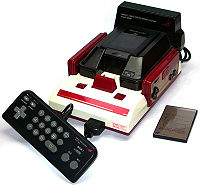
Famicom Modem
Encyclopedia

Nintendo Entertainment System
The Nintendo Entertainment System is an 8-bit video game console that was released by Nintendo in North America during 1985, in Europe during 1986 and Australia in 1987...
released only in Japan in 1988. It allowed the user access to a server that provided game cheats, jokes, weather forecasts, and a small amount of downloadable content. It could also be used to make live stock trades. Unlike the NES Teleplay Modem
Teleplay Modem
The Teleplay Modem was a modem for the Nintendo Entertainment System created by Keith Rupp and Nolan Bushnell, designed to provide online play between NES users, while also possessing compatibility with the Sega Genesis and Super Nintendo. The first prototype, called the "Ayota Modem", had a...
, it did not provide online play. The idea of downloading content would later be used in the Super Nintendo's Satellaview
Satellaview
The is a satellite modem add-on for Nintendo's Super Famicom system that was released in Japan in 1995. Available for pre-release orders as early as February 13, 1995, the Satellaview retailed for between ¥14,000 and 18,000 and came bundled with the BS-X Game Pak and an 8M Memory Pak.The...
, the Nintendo 64DD
Nintendo 64DD
The is a peripheral for the Nintendo 64 game console. It plugged into the N64 through the EXTension Port on the Nintendo 64's underside, and allowed the N64 to use proprietary 64 MB magneto-optical discs for expanded data storage...
, the GameCube
Nintendo GameCube
The , officially abbreviated to NGC in Japan and GCN in other regions, is a sixth generation video game console released by Nintendo on September 15, 2001 in Japan, November 18, 2001 in North America, May 3, 2002 in Europe, and May 17, 2002 in Australia...
, the Game Boy Advance Cable, the Nintendo DS's DS Download Play, the Wii's WiiConnect24
WiiConnect24
WiiConnect24 is a feature of the Nintendo Wi-Fi Connection for the Wii console. It was first announced at E3 2006 by Nintendo. It enables the user to remain connected to the Internet while the console is on standby...
, the Nintendo DSi
Nintendo DSi
The is a handheld game system created by Nintendo and launched in 2008 and 2009 in Japan, North America, PAL territories, and other regions. It is the third iteration of the Nintendo DS, and its primary market rival is Sony's PlayStation Portable...
's DSi Shop, and the Nintendo 3DS
Nintendo 3DS
The is a portable game console produced by Nintendo. The autostereoscopic device is able to project stereoscopic 3D effects without the use of 3D glasses or any additional accessories. The Nintendo 3DS features backward compatibility with Nintendo DS series software, including Nintendo DSi software...
' eShop
Nintendo eShop
The Nintendo eShop is an online service for the Nintendo 3DS handheld gaming system. Launched on June 6, 2011 in North America and June 7, 2011 in Europe and Japan, the eShop was enabled by the release of a system update that added the functionality to the 3DS' Home Menu...
.
See also
- Atari 2600Atari 2600The Atari 2600 is a video game console released in October 1977 by Atari, Inc. It is credited with popularizing the use of microprocessor-based hardware and cartridges containing game code, instead of having non-microprocessor dedicated hardware with all games built in...
's GameLineGamelineThe CVC GameLine was a cartridge for the Atari 2600 which could download games using a telephone line.In the early 1980s a cable pioneer named William von Meister was looking for a way to use his innovative modem transmission technology, recently acquired in ill-fated attempts of sending music to... - IntellivisionIntellivisionThe Intellivision is a video game console released by Mattel in 1979. Development of the console began in 1978, less than a year after the introduction of its main competitor, the Atari 2600. The word intellivision is a portmanteau of "intelligent television"...
's PlayCablePlayCableThe PlayCable system, introduced in 1981, allowed local cable-TV system operators to send Intellivision games over the wire alongside the normal TV signal... - Famicom Disk SystemFamicom Disk SystemThe was released on February 21, 1986 by Nintendo as a peripheral for the Family Computer console in Japan. It was a unit that used proprietary floppy disks for data storage. It was announced, but never released, for the North American Nintendo Entertainment System...
- Sega Genesis's Sega ChannelSega ChannelSega Channel was a project developed by Sega for the 16-bit Sega Mega Drive/Genesis console. Starting in December 1994, Sega Channel service was provided to the public by Time Warner Cable and TCI, which later was acquired by AT&T during its cable acquisition spree that formed AT&T...
- Nintendo Entertainment SystemNintendo Entertainment SystemThe Nintendo Entertainment System is an 8-bit video game console that was released by Nintendo in North America during 1985, in Europe during 1986 and Australia in 1987...
's Teleplay ModemTeleplay ModemThe Teleplay Modem was a modem for the Nintendo Entertainment System created by Keith Rupp and Nolan Bushnell, designed to provide online play between NES users, while also possessing compatibility with the Sega Genesis and Super Nintendo. The first prototype, called the "Ayota Modem", had a... - Super FamicomSuper Nintendo Entertainment SystemThe Super Nintendo Entertainment System is a 16-bit video game console that was released by Nintendo in North America, Europe, Australasia , and South America between 1990 and 1993. In Japan and Southeast Asia, the system is called the , or SFC for short...
's SatellaviewSatellaviewThe is a satellite modem add-on for Nintendo's Super Famicom system that was released in Japan in 1995. Available for pre-release orders as early as February 13, 1995, the Satellaview retailed for between ¥14,000 and 18,000 and came bundled with the BS-X Game Pak and an 8M Memory Pak.The...

